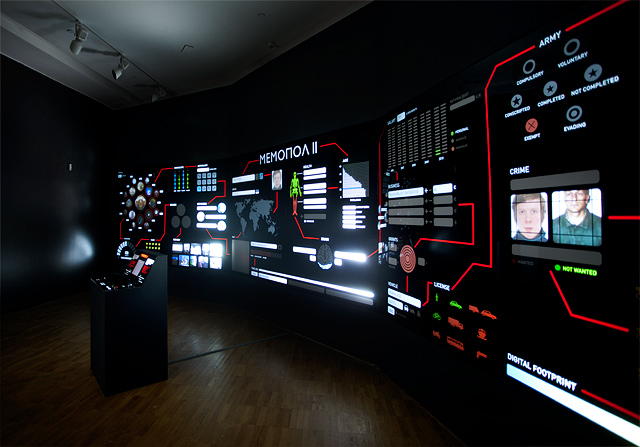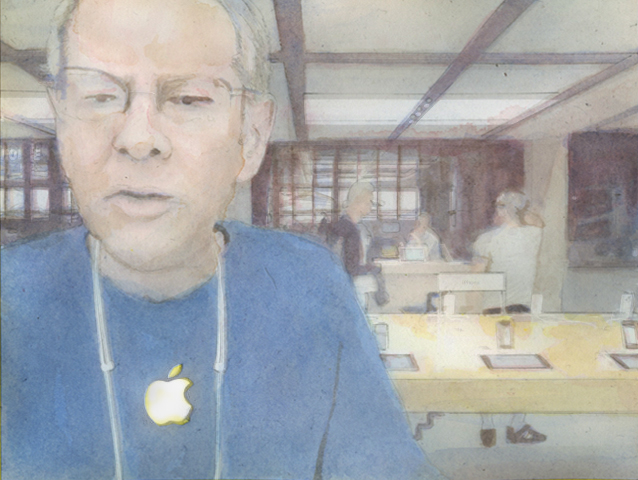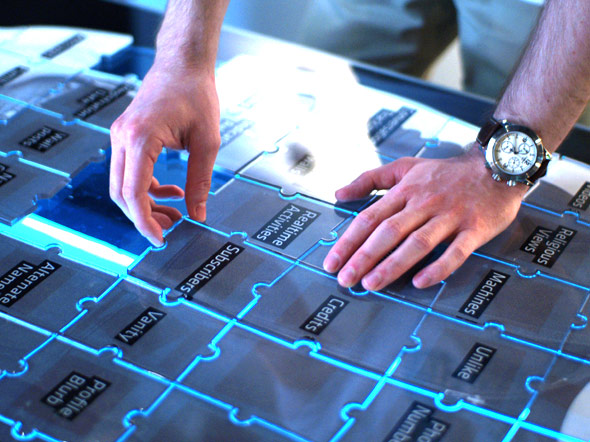I attended Ars Electronica this year and noticed their was a lot of art about privacy. I’ve written a Dutch blog post for the civil rights activists Bits of Freedom about these art works. You can read it below or find the original here.
Ieder jaar wordt in Linz (Oostenrijk) Ars Electronica Festival for Art, Technology and Society gehouden. Dit jaar barstte het festival van de privacy gerelateerde kunst. Hieronder een aantal highlights.
Memopol-2 van de Estlandse kunstenaar Timo Toots was de winnaar van de Golden Nica voor interactieve kunst. Deze dystopisch aandoende kamergrote installatie scant paspoorten van bezoekers en verzamelt daarmee zoveel mogelijk informatie online. Deze informatie wordt met een donkere en enge esthetiek getoond aan de bezoekers. Door slim met gegevens om te gaan wordt bijvoorbeeld niet alleen je geboortejaar maar ook het jaar waarop je statistisch gezien gaat sterven getoond.

Kyle McDonald is bekend van het controversiele project People Staring at Computers waarin hij met webcams foto’s maakte van nietsvermoedende computer gebruikers in Apple winkels in New York. Hij wilde met dit sousveillance project de lege blikken laten zien van mensen die computers gebruiken. Omdat McDonald in een juridische strijd met Apple verwikkeld is heeft David Pierce aquarellen gemaakt van een aantal van zijn foto’s. Die werden op het festival getoond.

Het project qual.net won een beurs. Deze open source technologie maakt het mogelijk om compleet ad hoc een netwerk te maken tussen verschillende apparaten met een Wi-Fi antenne. De netwerkverbindingen worden niet centraal geregeld maar verspreiden zich als een virus. qual.net kan dus gebruikt worden om Internet blokkades te omzeilen en is ook een goed alternatief voor overbelaste netwerken.
Het Ars Electronica centrum heeft op dit moment een vaste tentoonstelling getiteld Out of Control – What the Internet Knows About You waarin de verschuivende grens tussen publiek en privé wordt onderzocht. Drie projecten maakten indruk:
Newstweek bestaat uit een klein kastje dat je op kunt hangen op een plek met een draadloos netwerk (bijvoorbeeld een Starbucks). Het kastje logt in op het netwerk en corrumpeert de ARP tabellen zodat al het netwerkverkeer via het kastje loopt. Met een simpele webinterface kun je daarna de tekst van bekende nieuws websites (onder andere het NRC) aanpassen en je eigen propaganda creeëren. Gebruikers van het netwerk zien dan bij een bezoek aan de nieuws site jouw aangepaste tekst in plats van de originele tekst:
[vimeo http://vimeo.com/23075736]
Faceless is een wat ouder project van Manu Luksch. Zij heeft een film gemaakt door voor het oog van London’s surveillance camera’s een aantal scenes op te voeren. Door middel van recht op inzage verzoeken heeft zij vervolgens alle beelden van die scenes opgevraagd. Om de privacy van de ommestaanders te garanderen moeten al hun gezichten geanonimiseerd worden. Vandaar de titel Faceless.
De Oostenrijkse student Max Schrems heeft vorig jaar alle door Facebook opgeslagen informatie over hem opgevraagd. Na wat juridisch gesteggel heeft Facebook uiteindelijk een dossier van 1200 pagina’s opgeleverd. Een uitvoerige analyse van de gegevens laat zien wat voor soort gegevens allemaal door Facebook worden opgeslagen. Dit zijn niet alleen maar de connecties met je vrienden, je foto’s en je status updates, maar ook zaken als je laatst opgeslagen locatie, gegevens over alle apparaten waarme je Facebook gebruikt, de mensen waarmee je inmiddels geen vriend meer bent, en je complete log in geschiedenis (zie hier voor de ontnuchterende complete lijst). In het Ars Electronica centrum werden de 57 categorieën mooi verbeeld als verschillende puzzelstukjes die tezamen het lijf van Max Schrems legden.

Schrems is inmiddels een campagne gestart, Europe vs. Facebook, met vier eisen aan Facebook:
- Meer transparantie over de gegevens die door Facebook worden opgeslagen
- Opt-in in plaats van het nu gehanteerde opt-uit
- Echte controle over de eigen data door de gebruiker
- Data opslag minimalisatie
Daarnaast vindt Schrems het onacceptabel dat Facebook sommige gegevens voor eeuwig bewaard en gebruikers niet de mogelijkheid geeft om deze voorgoed te wissen.
Naast installaties over privacy was er aan de Donau nog veel meer interessante digitale kunst te zien. Ars Electronica is echt een aanrader.






